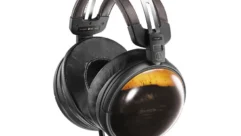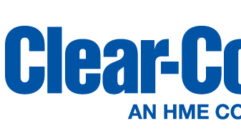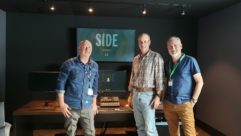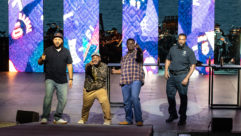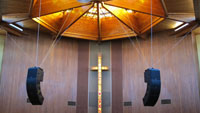

God’s Voice
Jan 18, 2012 1:07 PM,
By Carolyn Heinze
5 line array challenges
The Cathedral Ceiling
The sanctuary ceiling at Korean Presbyterian Church of Orange County in Westminster, Calif., soars into a 42ft. dome over a shallow, wide main seating space and several balconies. Beautiful and inspiring, no doubt, however congregation members seated in the corners, underneath the balconies, and in the balconies themselves had trouble hearing the sermons.
After 30 years of serving the community, it was time to give the more than 1,000 members of the congregation a quality sound experience. That goal—along with structural soundness—drove an upgrade executed by Aviwork, a design/build firm based in nearby Fullerton, Calif.

Aviworks updated the sound system for the Korean Presbyterian Church of Orange County that features QSC’s KLA12s and a KLA18 subwoofer flown in a left-right configuration.
Aviwork CFO and Senior AV Consultant Lake Hosung Leeman explains that the church is traditionally very conservative, but it is starting to incorporate a more contemporary worship style into its services. One of his concerns in designing the system was to accommodate musical performances while maintaining speech intelligibility. The system is flown in a left-right configuration, featuring four KLA12s and one KLA18 subwoofer per side. The loudspeakers are connected to a 32-channel Midas board, and digital signal processing is achieved through a dbx DriveRack 260.
Along with sonic quality, QSC’s unique SOLO (Single Operator Logistics) rigging system factored in Leeman’s choice he says. “KLA is a powered systems with an easy rigging system—you just need one bracket per side,” he says. Not only did the KLAs cut down on labor costs, he added, the rigging also met the church’s desire for structurally sound equipment as a means of earthquake protection.
So far, both Leeman and the church are pleased with the system. “The speakers cover all areas of the sanctuary completely, and I get so many compliments from congregation members,” he says. “They tell me it feels like the speakers are pouring down great sound on them.”
God’s Voice
Jan 18, 2012 1:07 PM,
By Carolyn Heinze
5 line array challenges

To support conventional and contemporary worship services at First Baptist Church in Orillia, Ontario, Canada, CHS Productions implemented a Renkus-Heinz PNX series line array.
The Big, Wide Bouncy Rectangle
Serving worshippers of all ages, the First Baptist Church in Orillia, Ontario, Canada, offers both conventional and contemporary-style worship services. This means clarity and horsepower matter equally in a space that was challenging to say the least.
Godfried van Rooij, chief design engineer and co-owner of nearby Collingwood, Ontario-based CHS Productions, explains that one of the biggest challenges was the configuration of the sanctuary itself. “Since the auditorium is very wide and the seating wraps around part of the front platform, sound dispersion becomes a very critical issue,” he says. A reflective rear wall in combination with mezzanine seating added to the equation.

Rooij notes that if CHS had opted for a traditional speaker system, multiple clusters would have been required in order to achieve enough coverage up front, with extra units to cover the mezzanine. He added that this design would have also resulted in slapback echo due to the reflections coming from the rear wall. There was also the issue of ceiling height: Because the roof is quite high, some of the clusters would have needed to be suspended low in order to provide any kind of coverage. Apart from this scenario being not very aesthetically desirable, multiple clusters would result in less sound clarity even when the delays were set properly. “This is because the delay can only be correct for a small area where the clusters overlap,” he says.
The implementation of a line array system enabled all sound to come from one point source, Rooij explains. “In this case, a Renkus-Heinz PNX series line array was used because of its very wide dispersion of 150 degrees and its very narrow controlled vertical dispersion of 7 degrees,” he says. The main cluster—comprised of three loudspeakers—is flown behind the video screen and a smaller array of two loudspeakers hangs behind the projector. Amplification is provided by Crest CA series amps, and processing is achieved through a Rane RMP26z. “Since two arrays were used, they could be aimed so that the sound was focused only on the seating areas, from the front row to the back wall, and to the mezzanine, hence avoiding slapback echo from the rear wall,” he says.
For Rooij, line array loudspeaker systems are literally a godsend for the house of worship market. “Church auditoriums very often can be an acoustical challenge,” he says. “A well-designed and installed line array will provide a good solution for years to come.”
God’s Voice
Jan 18, 2012 1:07 PM,
By Carolyn Heinze
5 line array challenges

After taking the acoustical measurements of Baker Memorial Chapel, DSL Sound AV contractor determined Community Professional Entasys three-way column line array system would not only achieve the desired sound intelligibility in the reflective space but would also not compromise the room’s aesthetic makeup.
The Slim, Highly Reflective Footprint
Community Professional Entasys
Housed on McDaniel College’s 160-acre campus in Westminster, Md., the Baker Memorial Chapel is one of the busiest facilities on the grounds. Built in 1958, the wood-panel and plaster chapel is used for worship services, concerts, presentations, baccalaureate and invocation ceremonies, weddings, memorial services, and speaking events.
When college administrators decided to replace the loudspeaker system, they recognized that the historic chapel’s highly reflective surfaces would present a number of issues in achieving the desired sound intelligibility. It was paramount, however, that any new system wouldn’t compromise the room’s aesthetic makeup. The challenge fell to Hagerstown, Md.-based audio/video contractor DSL Sound.
Robert Musser, sales consultant at DSL Sound, says that first thing he and his team did was take acoustical measurements of the space. From there, they began modeling the room with EASE acoustical modeling software, based on systems by three different manufacturers. “The client sat down and looked at the scoring from our EASE simulation along with the baseline of how the current system was performing, and from there they decided how much they wanted to invest in the new system,” he says. “The Community system was not at the highest or lowest price point, but it had a very nice, even distribution of sound and intelligibility, and we were able to feel quite confident going into this situation.”
Community Professional’s Entasys is a three-way column line array system encased in a compact design. For the Baker Memorial Chapel, DSL Sound installed two sets of three Entasys ENT-FR loudspeakers on each side of the proscenium, in addition to two Veris 210S subwoofers—powered by Crown CDI amplifiers—to cover the main floor. A London BLU-100 processor controls the system, and a 16-channel mixing console is used for musical performances.
In working with representatives from Community Professional, Musser determined that more speakers were better than less. “When I developed my EASE model with Community and said, ‘Here’s what I’m planning,’ they originally thought that I could get away with fewer boxes instead of having three per side; they thought I could get away with two,” he explains. “We were able to confirm that the room’s reverberation was a little lower in frequency; we saw a lot of energy traveling around the midsection.” A longer array offered more control over that part of the spectrum without exciting the room as much.
To adhere to the college’s aesthetic requirements, DSL Sound painted the speaker boxes to fit in with the rest of the chapel’s off-white décor. “These line arrays have a nice slim footprint, which helps to sell these products to the client,” Musser says. “Paintable products are always valued.” Mounted under the platform, the bass speakers are now hidden by a decorative grille. “You really have to look for the grille mark. Keeping a small footprint with good output is a real benefit.”
God’s Voice
Jan 18, 2012 1:07 PM,
By Carolyn Heinze
5 line array challenges

Evangel Church in Kansas City, Mo. wanted to provide its contemporary touring shows with more power, Special Events Services replaced legacy equipment with the Meyer Sound M’elodie line array system.
The Underpowered Touring Venue
As its programming shifted to incorporate a more contemporary style of worship, an attracted an array of touring praise bands, the leadership at the Evangel Church in Kansas City, Mo., recognized the need to replace a hodge-podge of legacy equipment with a purpose-built system.
Special Event Services—a design and installation firm based in Winston-Salem, N.Carolina—set out to give the 1,200-seat Evangel Church the kind of fidelity and sound-reinforcement that would support high-quality visiting acts.
Evangel Church resembles a concert venue with its flat front floor and rear stadium seating, but with limited power. Greg Slape, director of design-build services at Special Event Services, and a former pastor himself, looked at the physical and a programming factors and specified a Meyer Sound-based system design incorporating powerful stacks of M’elodie line arrays, supported with additional arrays, subs, fill speakers, and monitors.
Three M’elodie line arrays stacked eight high cover the majority of the front floor and stadium seating. Four Meyer 600-HP subwoofers cover the lower frequencies, with two Meyer M1D line arrays for front fills. Two Meyer UPJ-1P VariO loudspeakers are used for corner fills, and two UPM-1P loudspeakers provide choir monitoring overhead. A pair of UM-100P stage monitors support an existing in-ear foldback system. The entire system is managed by a Galileo loudspeaker management system, which is connected to an Avid Venue Profile console via a direct AES3 digital connection.
Slape recounts that the system proved the best match for Evangel Church not only due to its fidelity, but also because of its size and power efficiency, which addressed the facility’s power limitations. There was also another practical aspect to Slape’s choice: “There is a large rental supplier of Meyer products in town, and they can use them for other events when they need to augment this system,” he says, adding that the elements that factored into his selection were multi-faceted. “For myself, this is how I approach all of these projects: Not all of our projects are Meyer; not all of them are other brands. They really should—and hopefully do—reflect a comprehensive approach to their needs and requirements.” This means that programming outside of regular Sunday services must also be taken into consideration.
Having been a pastor himself before going into design/build, Slape is a well-placed witness to the evolution of AV in the house of worship market. He relays that the while churches have been integrating audiovisual technology into their facilities for quite some time, there is now an increased awareness of just how important this practice has become. “This has been going on for a long time,” he says, “Congregations are growing older; there are younger people coming in, and music styles are changing, and that will go on as long as the church is vibrant in the world.”
God’s Voice
Jan 18, 2012 1:07 PM,
By Carolyn Heinze
5 line array challenges

St. Mary Cathedral wasn’t getting sufficient speech intelligibility or natural sound from a 2004 loudspeaker install;Dickensheets Design Associates recommended the Tannoy QFlex 24s line array.
The Unintelligible Historical Building
Dating back to the 1870s—when it was known as St. Mary’s—St. Mary Cathedral is the seat of the Austin, Texas, diocese, encompassing 125 parish churches/communities and serving more than 450,000 parishioners. The facility’s design draws upon natural themes, featuring intricate vineries that intertwine with its murals, stately columns constructed to look like trees, and a star-dotted dome.
A costly loudspeaker system installed in 2004 was not delivering on speech intelligibility or the kind of natural sound that would match the church’s organic design, says Ken Dickensheets—principal consultant at the Austin-based acoustical consulting firm Dickensheets Design Associates—adding that the existing system had problems with reliability and service. Based on prior experience with both the room and the speakers, Dickensheets recommended replacing the system with Tannoy QFlex 24s arrays with the goal of fulfilling two main requirements: superior audio and a discreet aesthetic footprint.
“Empirically it was agreed by everyone involved in the project that the QFlex actually delivered higher speech intelligibility and a more natural sound than the more expensive arrays that they replaced,” Dickensheets says. Two QFlex 24s—mounted approximately eight feet from the floor—flank the chancel and face the front of the sanctuary head-on. Dickensheets admitted that this does place some of the mics directly in line with the loudspeakers, but he declares that there is no feedback. The project team also put the QFlex BeamEngine GUI to use to direct sound off of the rear wall while at the same time maintaining coverage for the main sanctuary and choir loft.
Tracy Frederick, technician and project manager at Austin Audio and Video—the firm that oversaw the actual install—noted that the most challenging aspect of this project was the installation of the brackets used to mount the speaker arrays on walls that date back to over a century. “They’re stucco but with natural limestone behind them, and they’re over 120 years old. But once the brackets were installed, the speakers went up easily,” he says.
A number of pre-existing devices were integrated with the QFlex system, such as an Ivie 884 auto mixer, Shure P-4800 digital signal processing, and a wireless microphone system by Audio-Technica. Several QSC CS series amplifiers drive the facility’s subwoofers in addition to the 70V loudspeakers that are installed in the narthex, cry room, and outdoor areas. Because there is no console, speech is mixed through the Iive unit; during musical performances, a remote control is connected to it, enabling users to transform it into a manual mixer. There are eight microphone inputs in all, four of which are wireless. Reinforcement for the choir is achieved through a separate system.
Carolyn Heinze is a freelance writer/editor.


